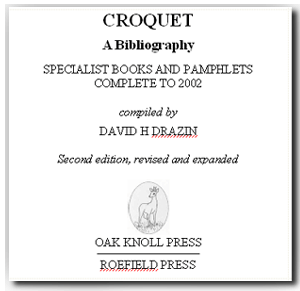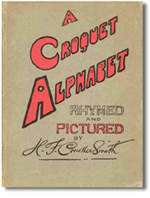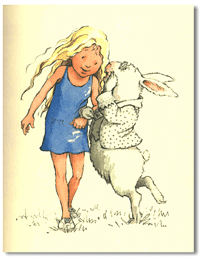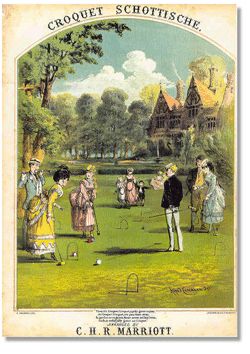

|
Back to |
| The Front Page |
| Letters & Opinion |
|
The lost literature of croquet
|
|||||||||||
|
by David Drazin
layout by Reuben Edwards Revised and updated February 20, 2005
|
|
||||||||||
Hot off the press is a new edition of the first systematic bibliography of croquet — the definitive bibliography of the literature of the sport and a must for collectors, book-dealers, and all scholars of the game.Croquet: A BibliographyThe contents of this new edition are listed in Croquet: A Checklist of Books, Pamphlets, and Patents. To mark its publication, the author picks out some special targets for bounty hunters — books that were definitely published, but have disappeared from view. If you have one of them on your bookshelf, let us tell the world: it will be the croquet bibliographer’s equivalent to the discovery of Tutankhamen’s tomb. Though this new edition of the author’s seminal work covers the same essential material — specialist books, pamphlets, and patents about the game of croquet – it is very much larger than the first edition and breaks important new ground. It includes several pre-existing works that had hitherto escaped the author’s attention along with much recent material, a new classified index of titles, and several hundred thumbnail illustrations, mostly in colour. More particularly, as a CD-Rom it offers valuable search facilities. There are over 1700 entries, comprising 633 titles of specialist books and pamphlets, 918 subsequent editions and variants, and 181 patent documents.
Specialist Books and Pamphlets Complete to 2002
Second edition, revised and expanded
Compiled by David H Drazin
Oak Knoll Press, USA
The expanding universe of croquet literature
When I started recording the literature of croquet systematically some twelve years ago, it struck me as self-evident that the task I had undertaken was finite, and hence that new finds would soon fall off to a slow trickle. And when I first published my bibliography five years ago, covering books and pamphlets specifically about croquet, I still imagined that the job was all but done, so I could move on to works of fiction and non-fiction that happen to include references to croquet and to the massive periodical literature. I even attempted to estimate the size of the universe, the total number of books about croquet ever published in any language.

|
| Croquet: A Bibliography compiled by David H Drazin. Second edition, revised and expanded. Co-published as a CD-Rom, readable with Adobe Reader 6.0, by Oak Knoll Press, New Castle DE, price $99.95, and Roefield Press, England. ISBN (USA) 1-58456-154-8, ISBN (UK) 0-9548690-0-1. Copies may be obtained directly from Oak Knoll’s transactional website www.oakknoll.com by searching the keyword ‘croquet’. |
Targets for bounty hunters

|
| A Croquet Alphabet (1913) by H.F. Crowther Smith. 'Crowther' was one of the game's most colourful and endearing characters. This charming volume launched his career as croquet's favourite caricaturist and wit. |
In the beginning was the word
But where is it now? The historians are generally agreed that the rules of croquet were first put into writing by Isaac Spratt, a fashionable London toy maker and retailer, some time in the 1850s. Spratt’s signed application for registration of the title ‘Rules of the New Game of Croquet’ at Stationers’ Hall, dated 15 November 1856, but recording the date of first publication as 2 August 1853, may be seen to this day in the UK Public Record Office. And a number of independent correspondents referred to this work in The Field, ‘The Country Gentleman’s Newspaper’, during the 1860s. So it is reasonable to assume that at some time it existed in the form of a printed document. But it is a remarkable fact that there has been no reported sighting of this work for more than a hundred years! It seems to have vanished into thin air. Whoever should set hands on a copy should not let it get away.
Irish mist
The source of Spratt’s rules is none too clear. One theory is that they came from Italy or the South of France, another that they came from Ireland, where croquet seems to have been played as far back as the 1830s. So any early croquet happening in Ireland merits investigation. A set of rules for the Oatlands Croquet Club is not known for certain to have existed as a publication in its own right; but these rules were set out by ‘Corncrake’ in The Field of 21 August 1858 and it is a fair bet that they were circulated in some form in County Meath, Ireland, very likely in print.
I owe this hunch to the spadework of Andrew Stevens, a local sports historian who recently visited some of the earliest reported Irish croquet venues, looking for clues as to the game’s origins. I was struck by the fact that, in the large-scale contemporary map of the area which he kindly sent me together with an account of his findings, the first three grounds referred to in the columns of The Field — namely Oatlands, Philpotstown, and Dormstown — were closely clustered within a few miles of Navan, the county town. And all three properties were extensive private estates, not towns or villages which I had expected, but failed, to find in a gazetteer. Meetings between the clubs which played at those venues were reported in The Field. Surely they must have been played according to an agreed code of rules, and it would seem therefore to follow that some such code must have been in circulation locally when Corncrake wrote to The Field, and that someone must have enshrined it in a document. Good luck to anyone who should turn up a copy.
Another vanishing trick....
It is clear from the records of Longmans, a long-established London publishing house, which I tracked down in the archives of Reading University Library, that John Jaques’s classic, Croquet: It’s Laws and Regulations, was first published in 1864. Mysteriously, the first edition of this work is described as ‘thoroughly revised’. Jaques didn’t say so explicitly, but I believe he used this turn of phrase to dissociate his new compilation from a more basic introductory manual that he had put together when he started selling croquet equipment some years previously. He is quoted by Arthur Lillie, writing in 1897 in his Croquet: Its History, Rules, and Secrets, as having said he did, and the surviving Registry Books of Stationers’ Hall show that he registered the title ‘Rules and Directions for Playing Croquêt, A New Outdoor Game’ on 16 July 1858 as having been first published on 14 July 1858. To this day there has been no known sighting of this work. Amazing!
...And yet another
For a few dollars more, bounty hunters may reasonably think that another lost title, The Rules of Croquet Revised and Corrected by an Old Hand, offers better prospects. This work, produced by the sixth Earl of Essex in 1863 or 1864 to support sales of his Cassiobury Set of croquet equipment, was promptly snuffed out by the vice-chancellor in response to an action for breach of copyright brought by Captain Mayne Reid, but not before an appreciable number — perhaps hundreds of copies — had found their way into the hands of customers.
At the time this was a big media event. In the words of the Boston Daily Advertiser, ‘His valuable monograph is therefore become extremely rare, and we advise antiquarians not to let a copy slip through their fingers. There is reason to hope, however, that Mr. Sibley will secure Harvard College library at least from such a distressing want’. Sadly, I have to report that Harvard University Library does not now hold a copy. In common with all other libraries I have searched, they must have missed a trick. But I can’t believe that hundreds of copies all vanished into thin air.
A Carrollian puzzle
Though the Rev Charles Lutwidge Dodgson, alias Lewis Carroll, was a meticulous cataloguer — he logged over 60,000 of his own letters — his handful of croquet works all present puzzles. The development of Castle Croquet: For Four Players is perhaps the most intriguing. As anyone who takes the trouble to look at the early texts will see, it has come down to us in two versions. The version known during Carroll’s lifetime was first published, in August 1867, in Aunt Judy’s Magazine. But, without explanation, Stuart Collingwood, his nephew and biographer, published a different version in The Lewis Carroll Picture Book in 1899.

|
| The young heroine in Alice's Adventures in Wonderland, Lewis Carroll's first adventure in croquet, visualised by Helen Oxenbury in a modern edition of his work by Walker Books (1999). |
When I looked into this discrepancy I learned that the accepted explanation was that Collingwood’s rendering incorporated revisions contained in a letter by Carroll to Macmillans, his publisher, dated 9 March 1875: ‘I enclose the Castle Croquet rules to try the experiment on. Would you get a copy of it set up in whatever style you think will look best?’ But this account didn’t ring true. The supposed revisions omitted three technical terms which had recently entered the croquet vocabulary, two by way of the ‘Field Rules’ which were first published on 7 April 1866, little more than a year before the appearance of Carroll’s work in Aunt Judy’s Magazine.
I couldn’t believe that Carroll would have abandoned these terms in favour of a more primitive exposition only eight years later. Following up this hunch, I obtained a copy of the supposed revisions that Macmillans had printed from Princeton University Library. To my astonishment, they were not revisions at all, merely an excerpt from the text found in Aunt Judy’s Magazine. Somehow someone had got the wrong end of a stick. So my hypothesis stands: the version Carroll published in 1867 would appear to be his last word on the game. But then, where did Collingwood’s text come from? My guess is that this version dates from about 1864 or 1865, and represents an earlier, unpublished, version of the game, which Carroll first committed to print under the title Croquet Castles: For Five Players in 1863. And, if I am right, there could be yet another old document out there to prove it. If you chance upon a cache of dusty manuscripts in spidery script, keep your eyes skinned.
The music of croquet
Sheet music, especially for voice and piano, was a huge market in the Victorian era. Pianos were in popular ownership, nearly everyone could play or sing something, and there was no competition from recorded music or radio. New pieces made their debut in public performance, typically at music halls, and were immediately bought, published, and promoted by a strong music industry. Something like a half of all publications registered at Stationers’ Hall during the period were music titles.

|
| Cover illustration by Alfred Concanen of C.H.R. Marriott's piano arrangement of Lawreen's and Davis's Croquet Schottische [1870]. Sheet music was big business in the era of crinoline croquet. |
Dance was a major market segment. Any activity or event of topical interest would inspire a dedicated polka, quadrille, waltz, tempo schottische, minuet, quick step, march etc. Croquet was at the height of its popularity here from about 1864 through 1872. Croquet parties were all the rage. The London and provincial town squares were converted into croquet grounds. And, of course, this was reflected in the music of the day. A front-page ad by Duff & Stewart, music publishers, in The Queen of 17 September 1870 listed no fewer than three croquet titles.
Despite the fact that Addison and Lucas, London music publishers, registered the title The Croquet Polka at Stationers’ Hall on 14 May 1864, I don’t entertain much hope of finding a copy of this work. Recent references to it all stem from the supposition that the front cover of a piece of sheet music of the same title (an American edition of the work registered in London?) was illustrated by Winslow Homer, the arch-iconographer of croquet. This connection apparently originates from a mention in an article about the artist in the December 25 1972 issue of Sports Illustrated magazine. But, again, we have no concrete evidence of any sighting ever. For such a popular genre as dance music, we might well ask, how could this be? My guess is that it was a ghost title, that Addison and Lucas planned to produce a croquet polka to cash in on the fashion for croquet dance, and registered the title to stake a claim, but somehow never got round to publishing it. And the supposed American work of the same title was probably a figment of mistaken identity. I do hope that someone is able to prove me wrong.
Click here to see the entire CHECKLIST OF BOOKS AND PAMPHLETS, and if you wish to report a rare find or ask a question of the author, email him at d.drazin@ntlworld.com.